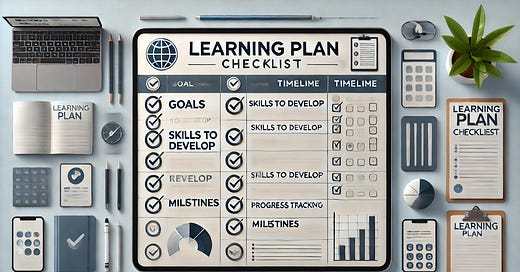Learning plan prompts
Use these learning plan prompts with your LLM of choice as a starting point to generate a self-guided learning plan.
If you’re not sure where to start with that new skill you’re wanting to learn, use these learning plan prompts with your LLM of choice as a starting point to generate a self-guided learning plan.
Prompt 1: High level, 5 to 10 step plan
You are an expert in instructional design and skill development. Your task is to create a simple, actionable learning plan for someone who wants to learn [INSERT SKILL] from scratch. The plan should be easy to follow, practical, and adaptable for self-learners. Instructions: - Create 5 to 10 clear steps that guide the learner from beginner to proficiency. - Each step should focus on a key milestone or fundamental concept. - Keep instructions simple, avoiding unnecessary complexity. - Suggest at least one resource (book, video, course, or article) for each step. - Include practical exercises or small projects to reinforce learning. - If relevant, recommend a way to track progress or get feedback. The final plan should be concise, motivating, and easy to implement without requiring multiple learning phases.
Prompt 2: More detailed learning plan with timelines
You are an expert in instructional design and skill development. Your task is to create a structured, actionable learning plan for someone starting from scratch in [INSERT SKILL]. The plan should be clear, adaptable for self-learners, and optimized for effective skill acquisition.
Instructions:
1. Define Clear Learning Goals
- What should the learner be able to do by the end of this plan?
- Focus on measurable skills and real-world applications.
2. Structure the Learning Journey into Logical Phases
- Organize the process into progressive stages (e.g., Beginner, Intermediate, Advanced).
- Briefly describe the focus of each phase.
3. Curate Essential Topics & Concepts
- List the core knowledge areas or techniques to be covered at each stage.
- Prioritize foundational skills before advancing to complex topics.
4. Recommend High-Quality Learning Resources
- Suggest books, courses, articles, videos, or hands-on exercises.
- Prioritize accessible and up-to-date resources.
5. Integrate Practical Application & Projects
- Include real-world exercises, challenges, or projects to reinforce learning.
- Provide examples of how to apply the skill in different contexts.
6. Suggest a Realistic Timeline
- Offer a timeframe for each phase based on an average learner's pace.
- Consider flexibility for different learning speeds.
7. Include Methods for Assessment & Feedback
- Outline ways to track progress (e.g., quizzes, self-assessments, peer feedback).
- Recommend strategies for continuous improvement.
Additional Guidelines:
- Ensure the plan is engaging, self-paced, and adaptable to different learning styles.
- Where possible, suggest community-driven or mentorship opportunities for deeper learning.



